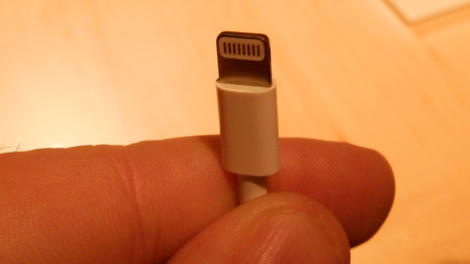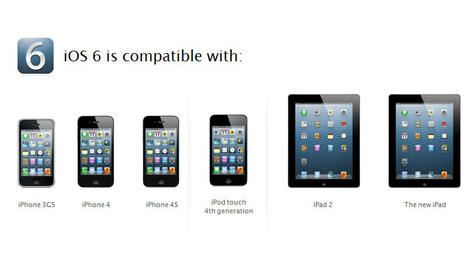Apple : Apple patents universal wireless iDevice dock |
- Apple patents universal wireless iDevice dock
- Apple avoids Motorola trouble, gets hit with Passbook patent suit
- iOS 6 adoption booming despite Apple Maps troubles
- In Depth: Intel Thunderbolt: what you need to know
| Apple patents universal wireless iDevice dock Posted:  Apple Tuesday was granted a patent for a universal wireless dock that could help ease the minds of users who have accumulated their fair share of iDevice accessories over the years. Filed as U.S. patent number 8,280,456, the universal dock appears to feature a single media player connector, presumably a Lightning connector, with an adapter for 30-pin iDevices and even non-Apple media players. "For various reasons, these media players may have different sized connectors. For example, the media players may be made by different manufacturers," the patent stated. "Also, they may be made by one manufacturer, but a newer media player may have a more advanced, smaller sized connector receptacle." The key to the dock is a wireless transmitter, which will send a signal to a receiver plugged into any existing iDevice accessory to solve the current incompatibility problem. Incompatibility aboundApple drew the ire of many fans when it introduced the Lightning connector with iPhone 5, iPod touch, and iPod nano. The smaller, reversible 8-pin connector replaces the 30-pin connector of legacy iDevices, making the new tech incompatible with existing accessories. Apple already sells an adapter for $29 (UK£25, AU$35), but the newly patented dock could offer a more elegant solution by wirelessly connecting any iPhone or iPod to compatible speakers regardless of whether it uses a 30-pin or Lightning port. The patent seems to contradict comments made recently by Apple's Senior Vice President of Marketing Phil Schiller, who said that there were no plans to make an iPhone 5 dock in the works. It's possible that Apple is just covering its bases against a potential third-party dock, but with the number of 30-pin accessories out there it certainly wouldn't hurt for the wireless dock to surface as an actual product. |
| Apple avoids Motorola trouble, gets hit with Passbook patent suit Posted:  In August, Motorola filed a complaint with the U.S. International Trade Commission (ITC) against Apple, accusing the company of violating seven of its patents. Nearly all Apple devices currently on the market figured into the complaint, including the iPod touch, several iPhones (including the iPhone 4S ), the iPad 2 and new iPad, as well as MacBook Pros and the MacBook Air. The ITC was scheduled to look into the filings, but Tuesday Motorola withdrew the complaint, giving Apple somewhat of a reprieve from its recent litigious predicaments. Had the ITC found Apple in violation of Motorola's patents, it could have imposed a U.S. sales ban on some or all of the products. However, that brief moment of relief was soon lost when Apple was named in another new suit, this time from a developer alleging Passbook blatantly infringes on several of its patents. Why Motorola's change of heart?It's entirely possible Motorola and Apple could've come to some sort of an arrangement or settlement on the patent issue. However, as Foss Patent pointed out, the motion to dismiss the charges made no mention of a deal between Apple or Motorola over the issue. Foss Patent's Florian Mueller said the recent appointment of Judge Theodore Essex to the case may have influenced Motorola's decision. As Mueller noted, Essex "doesn't make things easy for complainants," adding, "[m]aybe it's not just a coincidence that Motorola withdrew its complaint shortly after his appointment." Earlier this year, HTC withdrew its patent infringement claim against Apple, though in that instance HTC's case was thought to have little merit. TechRadar has reached out to Motorola, and will update this story if and when a request for comment is returned. Passbook problemsDespite dodging the proverbial patent bullet from Motorola, Apple now faces a potential suit from yet another company. Ameranth, a gaming and hospitality software developer, has filed a complaint with the ITC claiming Passbook violates four of its patents. Introduced in iOS 6, Passbook stores information like boarding passes, coupons, and customer loyalty cards in one convenient location for ease of use. The patents in question also deal with information storage and management, and to Ameranth, the way Passbook synchronizes that data is a bit too similar. In the suit, Ameranth not only claimed Apple was aware of the patent violations, but also that one patent in particular (6,384,850) was "cited as a prior art reference in two Apple iPhone patents issued to named inventors Bas Ording and Steven P. Jobs." Ameranth is looking to recover three times the amount of damages suffered as a result of Apple's infringements. TechRadar has reached out to Ameranth and Apple, and will update this story if and when a request for comment is returned. |
| iOS 6 adoption booming despite Apple Maps troubles Posted:  Apple's most recent OS release, the divisive iOS 6, hasn't gone off without a hitch, but the update's issues haven't stopped tons of Apple fans from upgrading their devices during the last half of September. iOS 6 was pushed out to compatible versions of the iPhone, iPad, and iPod touch on Sept. 19, and within one day, 15 percent of those devices were running the new OS, according to data from advertising and research firm Chitika. The most contentious aspect of Apple's new iOS 6 is easily the Apple Maps app that replaced Google Maps. It's been criticized for its inaccurate data and generally sloppiness. Nevertheless, iOS 6 adoption during the new OS's first two days of availability reportedly occurred 122 percent faster than iOS 5 upgrades when that OS version was released in 2011. iPhone vs. iPad vs. iPod touchAccording to Chitika's figures, which the firm deduced by tracking millions of users' mobile ad data from Sept. 18 to Oct. 1, iPhone users are the leaders in iOS 6 adoption. Up to 60 percent of iPhone users have already upgraded to the new iOS 6, while that number falls to 45 percent for iPad users and 39 percent for iPod touch users. As Slashgear pointed out, though, more hardware versions of the iPhone are compatible with iOS 6 when compared with the various iPad and iPod touch models, which may explain the higher upgrade rate for iPhone users. iOS 6 is compatible with the iPhone 3GS, iPhone 4, and iPhone 4S, and comes standard on the iPhone 5, though some features - like Siri - may be missing on older devices. On the other hand, any iPod touch released prior to the 4th gen iPod Touch won't vibe with iOS 6, and even the original iPad can't be upgraded to the new OS. So those lower adoption rates shouldn't come as a surprise. The loyalty of Apple fansApple's switch to its own internal maps app has caused quite a controversy, with Apple CEO Tim Cook publicly apologizing and even suggesting that iOS 6 users go with a competing maps app - like one from Microsoft or Google - for now. In fact, it seems based on some data that 24 out of 25 users took that advice to heart. But it's already been posited that iPhone users feel more brand loyalty than users of other smartphones, which may explain why they're choosing to upgrade their devices to iOS 6 despite the uproar over sloppy maps data. Then again, maybe they just can't stand the little red badge on their settings app that won't go away until they upgrade to the new OS. |
| In Depth: Intel Thunderbolt: what you need to know Posted:  Intel ThunderboltApple's laptops include a connectivity technology called Thunderbolt. But what is it? The answer, is that it's actually a rebrand of Intel's long-talked of Light Peak technology – Light Peak, it appears, was a codename. Thunderbolt is a new cable interface enabling you to connect up compatible devices – and, crucially, existing devices too. Thunderbolt also supports electrical cables as well as optical and it's this version of Thunderbolt that's in Apple's laptops. Read: New MacBook Pro review - with retina display
As Apple says, "Thunderbolt delivers PCI Express directly to external high performance peripherals such as RAID arrays, and can support FireWire and USB consumer devices and Gigabit Ethernet networks via adaptors."
THUNDERBOLT CABLES: Apple's cabling for Thunderbolt The tech also supports DisplayPort for HD displays and can, through more adaptors, connect up HDMI, DVI and VGA displays. So it's a connector that can replace literally all other connectors on your PC. Wow. If you're a peripherals manufacturer, you should be making Thunderbolt adaptors for everything, right now. So how fast is it? There's massive bandwidth available with Thunderbolt – up to 10 Gbps, which could grow by up to 10 times that by 2020.
Thunderbolt means you can now transfer an entire Blu-ray disc in 30 seconds or a year's worth of back-to-back MP3s in 10 minutes. And it's dual-channel, which means information can flow both ways, as you can see here:
Thunderbolt can also power bus-powered devices over the connections while Intel promises that files can have highly accurate time synchronisation too. Intel demonstrated the technology inside a laptop nearly a year ago when it sent two HD video streams across a single Light Peak connection. You can also daisy chain devices, seemingly without performance loss – there's a video of that in action here. Of course, Light Peak is intended as a replacement for current connectivity standards including USB and eSATA – in fact, it could be a replacement for all storage and display standards. Suddenly the MacBook Air, with its single USB port, doesn't look so limited. Surely MacBook Air 2011 means you'll be able to connect up everything via a single port. It clearly shows Apple also believes in Intel's new technology. Of course, that doesn't automatically mean it will be a success. Apple also put the ExpressCard into the MacBook Pro a while back and, due to the rise in wireless connectivity and USB mobile broadband, that has died a death.
HOW IT WORKS: A block diagram of Thunderbolt However, because this looks to be such a groundbreaking technology, it surely will seep into competing laptops and netbooks before long – depending on the duration of Apple's inevitable exclusivity deal of course. Despite the huge potential for connecting to legacy display and storage standards, Thunderbolt will also need mass adoption inside PCs for external display and storage devices to use it natively. One thing's for sure, if Intel and Apple can force the connection to permeate through the industry, it could be have interesting consequences for USB 3 and eSATA, which are still struggling to get a foothold in the market.
CONTROLLER: The Thunderbolt controller chip |
| You are subscribed to email updates from TechRadar: All latest Apple news feeds To stop receiving these emails, you may unsubscribe now. | Email delivery powered by Google |
| Google Inc., 20 West Kinzie, Chicago IL USA 60610 | |







No comments:
Post a Comment